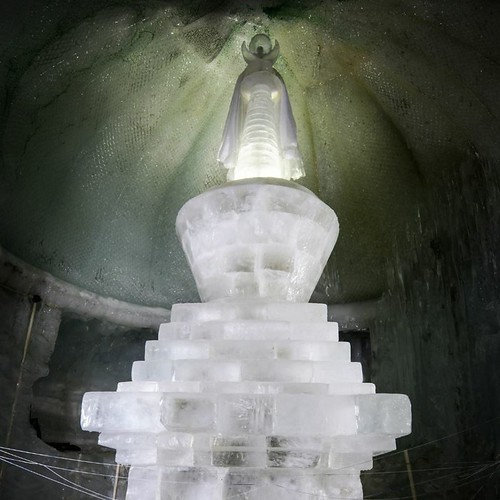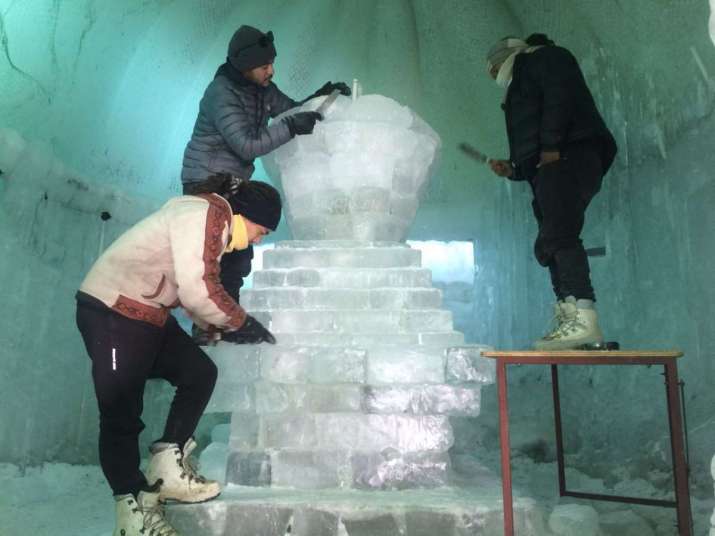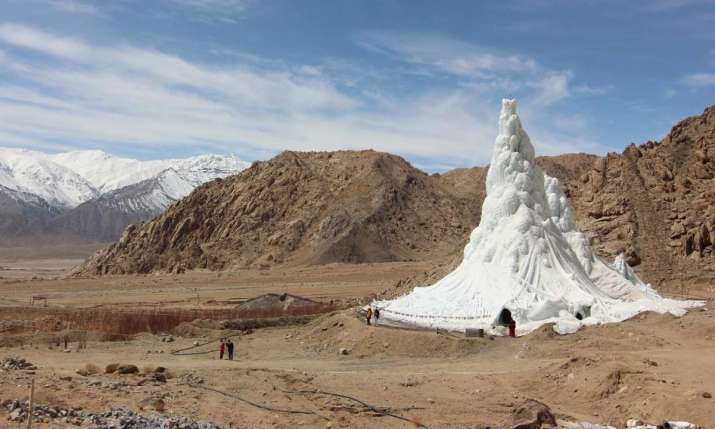
Like a growing number of vulnerable communities around the world, the people of Ladakh, a remote Himalayan region in the far northern Indian state of Jammu and Kashmir, are no stranger to the impact of climate change, living on the frontline of the battle with changing precipitation patterns and a growing water crisis in this high-altitude desert.
While an innovative local engineer named Sonam Wangchuk and a team of volunteers have developed and popularized a novel solution to the increasing problem of water shortages by growing artificial glaciers in the form of “ice stupas” (Tib: chorten) as a means to conserve winter water for local communities to use during the arid months of spring,* three young Ladakhi artists have sought to celebrate the endeavor by sculpting a chorten out of ice as a Buddhist symbol of the global struggle with climate change.

The high-altitude glaciers of the Himalaya, sometimes referred to as the Earth’s “third pole,” contain the largest concentration of frozen water outside of the planet’s two polar regions. These glaciers feed many of the region’s great rivers, including the Brahmaputra, the Ganges, and the Indus, helping to supply water to almost half of the world’s population, who use it for human consumption, agriculture, and hydro-energy. These essential glaciers have been disproportionately affected by warming global temperatures, which have impacted not only the glaciers themselves but by extension precipitation patterns on the vast Tibetan Plateau.
The three Ladakhi artists—Tsering Gurmet, Chemet Dorjay and Stanzin Khangsar—all in their twenties, sculpted the three-meter-high Changchup Chorten, which symbolizes the Buddha’s enlightenment, inside Wangchuk’s “ice stupa” near the village of Phyang, some 15 kilometers from the capital Leh. They began their work in January, completing the structure that is steeped in Buddhist symbolism in early February.
“If for our first time we had created a modern visual art, then people might not understand as it would be something new in Ladakh,” Gurmet explained. “The ice is an artificial glacier, but not a true chorten, so we though if we began with a composition of a chorten then it would be visually attractive as well as an easy medium for the people of Ladakh to understand, so that’s why we sculpted an ice chorten.” (YouTube)

“Art is for the community. It’s what they think, how they react and express themselves,” observed Dorjay. “What I witnessed was amazement in the eyes of the people seeing an ice stupa inside another for the first time. Moreover, the reaction of the local villagers was ‘okay it’s an ice stupa, but at the end it’s going to melt and benefit our farm and livestock.’ I believe it is a piece of artwork that is both visually attractive and materially beneficial for the people.” (YouTube)
The Changchup Chorten is also an economic endeavor as well as an artistic expression of an ancient spiritual tradition, and the artists hope it will encourage winter tourism in the area. There are even plans afoot to construct tourist accommodation and art galleries out of ice.
“After trying their hands on this stupa, HIAL Alternative University sent [the artists] to Kiruna near the arctic circle in Sweden to learn the art of creating ice hotels . . .” said ice stupa engineer Wangchuk in a Facebook post. “We aim to usher in winter tourism in the Phyang Valley in the coming years.”
Over the past 50 years, temperatures on the Tibetan Plateau have risen by 1.3ºC—three times the global average—causing glaciers to retreat, permafrost to deteriorate, and grasslands to degrade, accompanied by increasing desertification. Some studies have projected that more than two-thirds of the region’s glaciers could disappear by 2050. Coupled with erratic rain and snowfall, warmer temperatures are taking their toll, with rivers, streams, and lakes rapidly drying up.**
“They are carving it to tell the world that time is very precious and, like ice, it melts away,” said one observer who came to view the icy chorten. “It is a reminder to everyone that global warming is depleting our glaciers and, if we don’t act soon, we will all suffer the consequences. What we must take away from this wonderful initiative is the urgent need to find alternative solutions for such environmental challenges.” (The Better India)

* Ice Stupas Address Springtime Water Shortage in India’s Far North (Buddhistdoor Global)
** Dalai Lama Heads Call for International Action on Climate Change (Buddhistdoor Global)
See more
This Ladakhi Ice Sculpture Unites Buddhism And Fight Against Global Warming (The Better India)
Sonam Wangchuk (Facebook)
The ice stupas of Ladakh: solving water crisis in the high desert of Himalaya (The Guardian)
Artificial glacier could help Ladakh villagers adapt to climate change (The Guardian)












